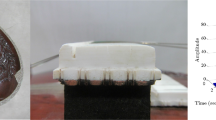Abstract
The objective of this study is to demonstrate, both analytically and experimentally, that certain resonant frequencies of complex continuous systems can be suppressed when common laboratory testing techniques are employed. A taut string is used as the physical system for demonstrating the phenomenon of resonant-frequency suppression.
Four steady-state sinusoidal excitation conditions are considered. The first two test conditions consist of dynamic loads which result when the ends of the string move vertically with equal amplitudes which are exactly in phase [case (i)] or out of phase [case (ii)]. The second two test conditions consist of a single-point force [case (iii)] and displacement input [case (iv)] located somewhere along the length of the string.
The analytical solution shows that theeven multiples of the fundamental resonant frequency are suppressed for case (i), theodd multiples are suppressed for case (ii), and those resonant frequencies are suppressed for case (iii) which make the excitation point a nodal point, while for case (iv) those resonant frequencies are suppressed which do not have a node corresponding to the excitation point. The experimental results verify the general predictions of resonant-frequency suppression given by the analysis.
While this study is basically phenomenological and qualitative in nature, the results clearly indicate that (i) the most common means of vibration testing using shakers, i.e., condition i, will suppress certain resonant frequencies for the physical system used in this study as well as other similar systems; (ii) the practice of applying a concentrated excitation force or input motion will suppress certain resonant frequencies which depend on nodal points corresponding to the concentrated excitation point; and (iii) extreme caution must be exercised if all significant resonant frequencies are to be obtained for this simple system as well as more complex systems by vibration tests in the laboratory.
Similar content being viewed by others
Abbreviations
- A :
-
unknown constant
- a :
-
length of string
- B :
-
unknown constant
- b :
-
location of concentrated excitation input
- C :
-
wave velocity
- e :
-
natural logarithmic base
- F o :
-
magnitude of excitation force
- F(t) :
-
time-dependent excitation force
- f :
-
amplitude of imput motion
- j :
-
\(\sqrt { - 1} \)
- m :
-
mode number to left of excitation point
- n :
-
mode number of original system
- q :
-
mode number to right of excitation point
- T :
-
tension force in string
- t :
-
time
- U o :
-
input-motion amplitude at excitation point
- u(x,t) :
-
displacement of string over intervalo<x<a
- u i (x,t):
-
displacement ofith section of string
- v(x) :
-
maximum displacement of string at any point
- x :
-
spatial coordinate locating any point on string
- α:
-
proportionality constant between left and right input motion
- λ:
-
eigenvalue corresponding to natural frequencies
- ρ:
-
mass per unit length of string
- ω:
-
excitation frequency
References
Pipes, L. A., Applied Mathematics for Engineers and Physicists, McGraw-Hill Book Co., New York, N. Y., 2nd ed., 427–470 (1958).
Meirovitch, L., Analytical Methods in Vibrations, The Macmillan Co., New York, N. Y. 143–161 (1967).
Thomson, W. T., Vibration Theory and Applications, Prentice-Hall, Inc., Englewood Cliffs, N. J., 140–143 (1965).
Author information
Authors and Affiliations
Rights and permissions
About this article
Cite this article
McConnell, K.G. Some implications of vibration testing of continuous systems for resonant frequencies. Experimental Mechanics 9, 321–326 (1969). https://doi.org/10.1007/BF02325138
Issue Date:
DOI: https://doi.org/10.1007/BF02325138




